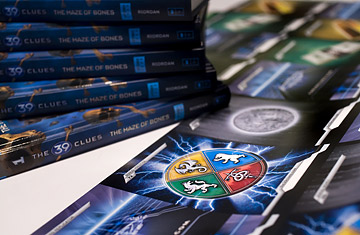
Scholastic launches its first major post–Harry Potter series with The 39 Clues and related products, including trading cards and an online game
(2 of 2)
That's one of the advantages of doing business this way, without a single author. By rotating writers, Scholastic can put out 39 Clues novels at Gatling-gun speeds: there will be a total of 10, a new one appearing every three or four months. Another advantage is that it allows Scholastic to retain ownership and control of the intellectual property they're selling. Harry Potter quickly made J.K. Rowling one of the richest women in the world. But Amy and Dan are company property. In the post-Potter world, publishers realize there's too much money at stake to risk letting a mere author get his or her ink-stained hands on it.
But there's also a disadvantage. The post-author approach gives The 39 Clues a synthetic, focus-grouped quality. It's nothing you can easily point to. It's just the absence of anything risky or anything strange. The Maze of Bones is scrupulously smooth and generic and meticulously calculated to appeal to everyone and offend no one. As the product of a corporate hivemind, it isn't stamped with the signature quirks of a single distinctive authorial sensibility. If it were a baby it wouldn't have a belly button.
That doesn't make The 39 Clues hard to read. But it does make it hard to fall in love with.
Beyond the First DimensionIn June the 39 Clues team got a major boost: DreamWorks acquired the film rights, with Steven Spielberg planning to produce and direct. "The 39 Clues takes creative leaps to expand the story experience from the pages of the books to multiple stages of discovery and imagination," Spielberg said, in an uncharacteristically robotic statement. "We have the opportunity to develop this property that says 'film,' 'family,' 'fun' and 'franchise.' "
Which brings us to the second, more unusual aspect of The 39 Clues: those "multiple stages of discovery and imagination" Spielberg mentioned. When you buy a copy of The Maze of Bones, you'll find a pocket in the inside front cover that contains a pack of six trading cards. If you like them, you can buy more — there are 355 cards in all — and trade them with your friends. The cards come with various points and clues and puzzles on them, in a system so complicated you would have to be 13 years old or younger to understand it. With cards in hand you can visit a website — the39clues.com — where you can create an account and play an online game that involves finding more clues. This makes you eligible to win cash prizes. If you find all 39 clues you could win the grand prize of $10,000. Which you could maybe use to buy yourself a 39 Clues backpack.
In other words, while it's ostensibly a series of books, The 39 Clues arrives already encased in an exoskeleton of extraliterary material: trading cards, online game, sweepstakes, movie, merchandise. Levithan calls this approach "multi-dimensional publishing." "We are trying to create a new model for publishing and launch it in the biggest way possible," he explains. "Which for us is pretty big." The 39 Clues has been Pokemonetized.
The strategy here is: more is more; success by any medium necessary. For Scholastic those ancillary products aren't just additional sources of revenue — though they're sure as shootin' that too — they enhance the overall entertainment experience. "That was really the genesis of this," Riordan says. "How can we make an experience that's not simply the book, that's all these other elements as well, that get the reader involved in a number of different ways — that really get kids where they live? What are they interested in, and how can we get them hooked into this series?" After all, Harry Potter evolved most of these accoutrements over the lifetime of the series. So for The 39 Clues, why not build them right in, right from the start?
But it's hard not to suspect that in this case more just might possibly be less — that with every extra dimension you pile onto The 39 Clues, it doesn't become more of a rich, immersive experience; instead the book at the heart of its little universe just becomes a little less of a book. Levithan argues that the principle of the thing remains the same, regardless of the media it's packaged in. "The technology changes, but it's all about being in your backyard, being Luke Skywalker and Han Solo," he says. "It's that role-playing; it's about being involved in a story. That's what kids want." But what if those extra dimensions send kids the message that for a story to feel real, a mere book isn't enough? With its glossy clear plastic front cover, The Maze of Bones hardly looks like a book at all. It looks like a toy. Like Voldemort and his horcruxes, its soul has been divided among multiple vessels. But what Voldemort failed to understand, of course, is that each division diminishes the whole.
The irony of The 39 Clues is that, like practically all children's entertainment, the books themselves pay lip service to the beauty and value of books. Amy is an obsessive reader — "Young lady, close that book!" her aunt snaps at her in the second chapter of The Maze of Bones. Likewise, one of the novel's key scenes takes place in grandmother Grace's secret library. "She loved books," we learn. "She loved them very much." But would Amy or Grace have picked up The Maze of Bones? Scholastic's strategy seems to be predicated on the idea that kids don't actually like to read at all, that they have to be bribed to do it with trading cards and video games and cash. Undoubtedly there are many lessons publishers can learn from Harry Potter. But that isn't one of them.
